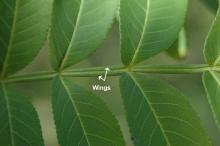Pterocarya stenoptera
Common name:
Chinese Wingnut
Pronunciation:
ter-o-KA-ri-a sten-OP-ter-uh
Family:
Juglandaceae
Genus:
Type:
Broadleaf
Native to (or naturalized in) Oregon:
No
- Broadleaf deciduous tree, 40-90 ft (12-27 m) tall, 30-50 ft (9-15 m) wide, wide spreading limbs. Leaves alternate, pinnately compound, 20-40 cm long, usually 11-23 leaflets, sometime terminal leaflet absent, each leaflet 5-13 cm long and about 1-5 cm wide, oblong or narrowly oval, finely and regularly toothed; the rachis between leaflets in winged and sometimes serrate; leaves green and no color change in fall. Female catkins 18-36 cm long, green, not showy. Fruit (nut) in long narrow clusters, each fruit about 2 cm long with oblong wings, green to brown.
- Sun; does well in compacted soil, such as high traffic areas. Because of aggressive roots it is not recommended for lawns or gardens.
- Hardy to USDA Zone (5)6 Native to China, where it is widely grown as a shade tree.
- Pterocarya stenoptera is similar in appearance to Pterocarya fraxinifolia, Caucasian Wingnut, however, the leaf rachis of P. stenoptera is winged and sparsely toothed whereas the rachis of P. fraxinifolia is cylindrical.
- stenoptera: narrow-winged
- Portland, Oregon: Hoyt Arboretum





